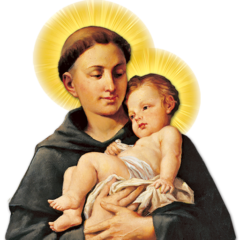Novena to Our Lady of Czestochowa
The Black Madonna of Częstochowa (Polish: Czarna Madonna or Matka Boska Częstochowska), also known as Our Lady of Częstochowa, is a venerated icon of the Blessed Virgin Mary housed at the Jasna Góra Monastery in Częstochowa, Poland. Several Pontiffs have recognised the venerated icon, beginning with Pope Clement XI who issued a Canonical Coronation to the image on 8 September 1717 via the Vatican Chapter.
The icon of Our Lady of Częstochowa has been intimately associated with Poland for the past 600 years. Its history prior to its arrival in Poland is shrouded in numerous legends which trace the icon’s origin to St. Luke who painted it on a cedar table top from the house of the Holy Family. The same legend holds that the painting was discovered in Jerusalem in 326 by St. Helena, who brought it back to Constantinople and presented it to her son, Constantine the Great.
Our Lady declared as Queen and Protectress of Poland
In August 1382 the hilltop parish church was transferred to the Paulites, a hermitic order from Hungary. The golden fleur-de-lis painted on the Virgin’s blue veil parallel the heraldic azure, semée de lis, or of the French royal coat of arms and the most likely explanation for their presence is that the icon had been present in Hungary during the reign of either Charles I of Hungary and/or Louis the Great, the Hungarian kings of the Anjou dynasty, who probably had the fleur-de-lis of their family’s coat of arms painted on the icon. This would suggest that the icon was probably originally brought to Jasna Gora by the Pauline monks from their founding monastery in Hungary.
The Black Madonna is said to have miraculously saved the monastery of Jasna Góra (English: Bright Mount) from a Swedish invasion. The Siege of Jasna Góra took place in the winter of 1655 during the Second Northern War, as the Swedish invasion of the Polish-Lithuanian Commonwealth is known. The Swedes were attempting to capture the Jasna Góra monastery in Częstochowa. Seventy monks and 180 local volunteers, mostly from the szlachta (Polish nobility), held off 4,000 Swedes for 40 days, saved their sacred icon and, according to some accounts, turned the course of the war. This event led King John II Casimir Vasa to give what has become known as the Lwów Oath in which he submitted the Polish Commonwealth under the protection of Our Lady and proclaimed her Queen of Poland in the cathedral of Lwów on 1 April 1656. Prior to this event, several royal nobilities have offered crowns to the image throughout the years, replacing its iron sheet crown by gold and several jewels. In later years, various jewels were interchanged and repositioned around the image to preserve the aesthetic of the icon with the replacement of stolen crowns.
Legends about the Madonna’s appearance
Black Madonna mosaic at Jasna Góra.
The legend concerning the two scars on the Black Madonna’s right cheek is that the Hussites stormed the Pauline monastery in 1430, plundering the sanctuary. Among the items stolen was the icon. After putting it in their wagon, the Hussites tried to get away but their horses refused to move. They threw the portrait down to the ground and one of the plunderers drew his sword upon the image and inflicted two deep strikes. When the robber tried to inflict a third strike, he fell to the ground and writhed in agony until his death. Despite past attempts to repair these scars, they had difficulty in covering up those slashes as the painting was done with tempera infused with diluted wax.
Veneration
Częstochowa is regarded as the most popular shrine in Poland, with many Polish Catholics making a pilgrimage there every year. A pilgrimage has left Warsaw every August 6 since 1711 for the nine-day, 140-mile trek. Elderly pilgrims recall stealing through the dark countryside at great personal risk during the German Nazi occupation. Pope John Paul II secretly visited as a student pilgrim during World War II.
The feast day of Our Lady of Częstochowa is celebrated on August 26.




